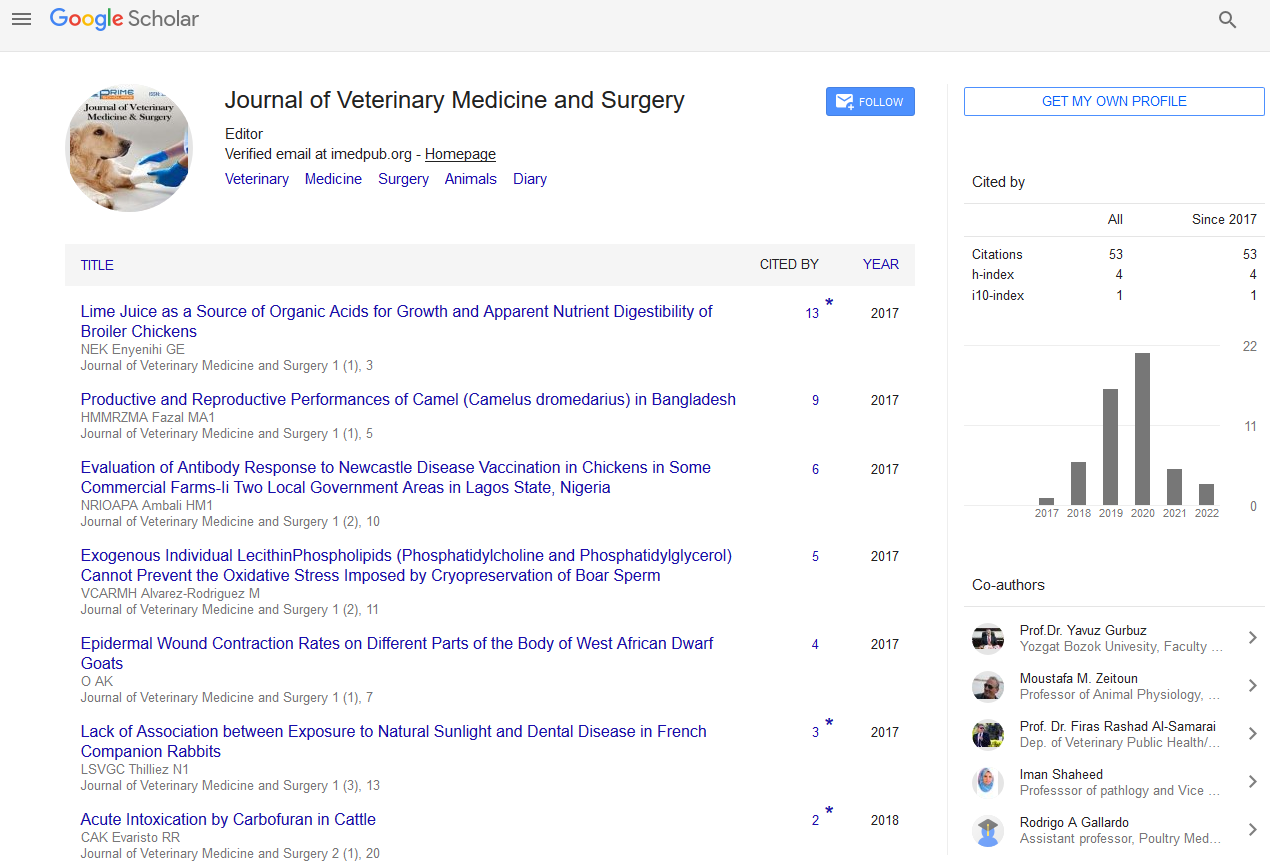Opinion - (2024) Volume 8, Issue 2
The Silent Epidemic: Understanding Feline Upper Respiratory Infections
Daphne Joyce*
Department of Veterinary Science, University of Kent, UK
*Correspondence:
Daphne Joyce,
Department of Veterinary Science, University of Kent,
UK,
Email:
Received: 29-May-2024, Manuscript No. IPJVMS-24-20560;
Editor assigned: 31-May-2024, Pre QC No. IPJVMS-24-20560 (PQ);
Reviewed: 14-Jun-2024, QC No. IPJVMS-24-20560;
Revised: 19-Jun-2024, Manuscript No. IPJVMS-24-20560 (R);
Published:
26-Jun-2024, DOI: 10.36648/2574-2868.8.2.20
Introduction
Cats, with their grace and independence, are often considered
low-maintenance pets. However, their health can be
surprisingly delicate, particularly when it comes to Upper
Respiratory Infections (URIs). These infections are not only
common but can also be quite severe, affecting both domestic
and feral cat populations worldwide. Understanding the
causes, symptoms, treatment, and prevention of feline URIs is
crucial for ensuring the well-being of our feline companions.
Feline upper respiratory infections are primarily caused by
viral and bacterial agents. The two most common culprits are
the Feline Herpesvirus (FHV-1) and Feline Calicivirus (FCV).
These viruses are highly contagious and can spread rapidly in
environments where cats are in close contact, such as shelters,
catteries, and multi-cat households. Transmission occurs
through direct contact with an infected cat or via fomites
objects contaminated with infectious agents, such as food
bowls, litter boxes, and human hands. Sneezing and coughing
can aerosolize the pathogens, further facilitating their spread.
Cats of all ages can be affected, but kittens, elderly cats, and
those with compromised immune systems are particularly
vulnerable.
Description
The clinical signs of feline URIs can range from mild to severe.
Common symptoms include sneezing, nasal discharge,
conjunctivitis, and ocular discharge. Infected cats may also
exhibit lethargy, loss of appetite, and fever. Severe cases can
lead to pneumonia or chronic respiratory issues. Diagnosis is
typically based on the clinical presentation and history of the
cat. In some cases, veterinarians may perform additional tests,
such as Polymerase Chain Reaction (PCR) assays, to identify
the specific pathogens involved. This can be particularly useful
in guiding treatment and management strategies. There is no
cure for the viral causes of feline URIs, and treatment primarily
focuses on supportive care. This can include ensuring adequate
hydration and nutrition, as well as administering medications to
alleviate symptoms. Antibiotics may be prescribed to address
secondary bacterial infections. In severe cases, hospitalization
and intensive care may be necessary. Veterinarians often
recommend isolating infected cats to prevent the spread of
the disease. Maintaining a clean environment and practicing
good hygiene, such as frequent hand washing and disinfection
of common areas, are essential in controlling outbreaks.
Preventing feline upper respiratory infections involves a
combination of vaccination, good husbandry practices, and
early intervention. Core vaccines, such as those for FHV-1 and
FCV, are highly effective in reducing the incidence and severity
of URIs. These vaccines are typically administered to kittens in
a series, followed by regular boosters throughout the cat’s life.
Reducing stress in cats is another crucial preventive measure.
Stress can weaken the immune system, making cats more
susceptible to infections.
Conclusion
Feline upper respiratory infections are a significant health
concern that can impact the quality of life for affected cats.
While these infections are often manageable with appropriate
care, they highlight the importance of preventive measures and
early intervention. By understanding the causes, symptoms,
and treatments of URIs, cat owners and caregivers can play
a vital role in safeguarding the health of their feline friends.
As with many health issues, proactive care and vigilance are
the best defenses against the silent epidemic of feline upper
respiratory infections.
Acknowledgement
None.
Conflict Of Interest
None.
Citation: Joyce D (2024) The Silent Epidemic: Understanding Feline Upper Respiratory Infections. J Veterinary Med. 8:20.
Copyright: © 2024 Joyce D. This is an open-access article distributed under the terms of the Creative Commons Attribution License, which permits unrestricted use, distribution, and reproduction in any medium, provided the original author and source are credited.

